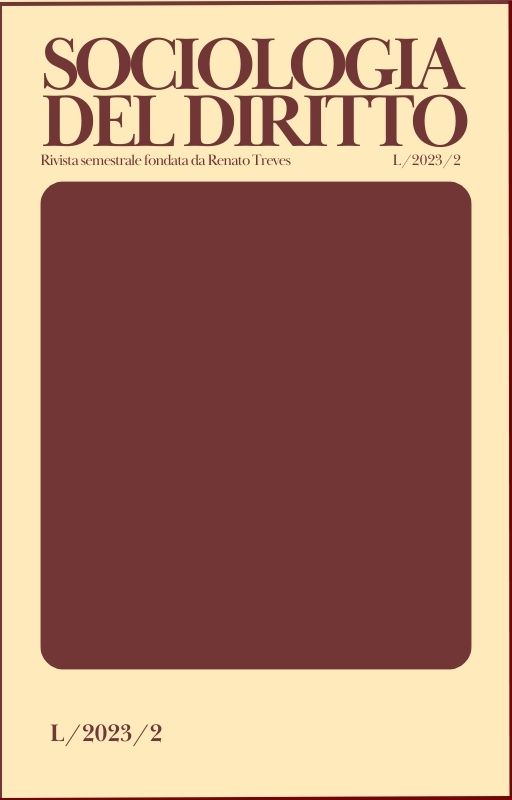Essays
Published 2024-01-30
Keywords
- food quality,
- sustainability,
- geographical indications
Copyright (c) 2023 Emma Sofia Lunghi

This work is licensed under a Creative Commons Attribution-ShareAlike 4.0 International License.
Abstract
European legislation on food quality provides for two levels of standards: health safety, and organic and geographical quality. The regulation on quality schemes does not define common quality criteria but protects a presupposed uniqueness of foods justified by territory, tradition, and organoleptic properties. Through the analysis of seven product specifications, this article aims to discuss whether the territory of origin and the organoleptic properties of foods are sufficient criteria to define food quality and whether the link to the territory is a sufficient criterion to consider geographical indications as environmentally sustainable production. Socio-legal research needs to examine, on the one hand, the categories of certified foods and the production systems in which they are found; on the other hand, whether the certification symbols enable consumers to recognize products of superior quality.
Downloads
Download data is not yet available.
References
- La Repubblica, Alluvione in Romagna, la strage degli alberi da frutto: al mercato niente più pesche, pere, mele, susine, kiwi e ciliegie, (22 maggio, 2023), consultabile all’indirizzo: https://www.repubblica.it/cronaca/2023/05/22/news/alluvione_emilia_romagna_strage_frutta_allevamenti-401188242/
- Bava, L., Bacenetti, J., Gislon, G., Pellegrino, L., D’Incecco, P., Sandrucci, A., Tamburini, A., Fiala, M., Zucali, M. (2018), Impact assessment of traditional food manufacturing: The case of Grana Padano cheese. Science of The Total Environment, 626, 1200–1209.
- Callois, J.-M., Fartsi, I., Ngoulma, J., & Jeanneaux, P. (2019), Perception de la qualité par la distribution et dynamique des ventes. Le cas des AOP fromagères d’Auvergne, Économie Rurale, 370, 7–27.
- Cardon, P., Depecker, T., & Plessz, M. (2019), Sociologie de l’alimentation, Armand Colin.
- Carter, D. P., e Cachelin, A. (2019),The Consumer Costs of Food Certification: A Pilot Study and Research Opportunities, Journal of Consumer Affairs, 53(2), 652–661.
- Il Post, C’è una grossa crisi per le pere italiane, (22 settembre 2022), consultabile all’indirizzo: https://www.ilpost.it/2022/09/23/pere-italia-crisi/#:~:text=La%20produzione%20di%20pere%20italiane,ridotte%20del%2015%20per%20cento
- Cozzi, S. (2018), “La distribuzione commerciale in Italia; caratteristiche strutturali e tendenze evolutive”, Istat. (rapporto)
- Fino, M. A., e Cecconi, A. C. (2021), Gastronazionalismo: Come e perché l’Europa è diventata indigesta, People.
- Grandi, A. (2022), Denominazione di origine inventata le bugie del marketing sui prodotti tipici italiani, Mondadori.
- Ritchie, H., Rosado, P., e Roser, M. (2022), Environmental Impacts of Food Production. [Online] Consultabile all’indirizzo: OurWorldInData.Org. https://ourworldindata.org/environmental-impacts-of-food (Data di accesso: 20 settembre 2023)
- Ministero dell’Agricoltura (senza data), Qualità. [Online] Consultabile all’indirizzo: https://www.politicheagricole.it/flex/cm/pages/ServeBLOB.php/L/IT/IDPagina/309 (Data di accesso: 29 luglio 2023)
- Alimentando, Pera dell’Emilia-Romagna: Crollo produttivo del 40%, (26 luglio 2023), consultabile all’indirizzo: https://www.alimentando.info/pera-dellemilia-romagna-crollo-produttivo-del-40/
- Petridou, E., (2005), Au pays de la feta: Négociation de la grécité dans le contexte européen. Ethnologie Française, Vol. 35(2), 255–265.
- Poore, J., e Nemecek, T, (2018). Reducing food’s environmental impacts through producers and consumers, Science, 360(6392), 987–992.
- Régnier, F., Lhuissier, A., e Gojard, S., (2006), Sociologie de l’alimentation, la Découverte.
- Sandström, V., Valin, H., Krisztin, T., Havlík, P., Herrero, M., e Kastner, T, (2018), The role of trade in the greenhouse gas footprints of EU diets, Global Food Security, 19, 48–55.
- Serra, O., & Wolikow, S., eds., (2022), Des appellations d’origine aux indications géographiques: Cent ans de protection de l’origine et de la qualité. Presses universitaires de Rennes.
- Ventura Bordenca, I, (2022), Food packaging: Narrazioni semiotiche e branding alimentare (1. ed). Franco Angeli.

